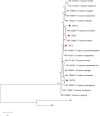Isolation and identification of endophytic fungi from Conyza blinii that exhibit antioxidant and antibacterial activities
- PMID: 40416615
- PMCID: PMC12101443
- DOI: 10.7717/peerj.19464
Isolation and identification of endophytic fungi from Conyza blinii that exhibit antioxidant and antibacterial activities
Abstract
Background: As a medicinal plant, Conyza blinii is known to contain a wealth of bioactive constituents, including flavonoids, terpenes, and triterpenoid saponins, which contribute to its anti-inflammatory and anticancer properties. Endophytic fungi, which symbiotically inhabit plant tissues, are recognized for their ability to synthesize bioactive metabolites analogous to those of their hosts. However, the potential of C. blinii-associated endophytes remains underexplored. This study aims to isolate and characterize phenols-producing endophytic fungi from C. blinii, evaluate their biological activities, and analyze their chemical components to provide new insights for drug development.
Methods: During the study, 20 endophytic fungi were isolated from C. blinii. The Folin-Ciocalteu method was used to screen for strains capable of producing phenolic compounds. To assess their bioactivity, ethyl acetate extracts of different concentrations were tested for antibacterial and antioxidant activities. Antibacterial activity was evaluated using minimum inhibitory concentration (MIC) determinations, while antioxidant activity was assessed through 2,2-Diphenyl-1-picrylhydrazyl (DPPH) radical, 2,2'-Azinobis-(3-ethylbenzthiazoline-6-sulfonic acid) (ABTS) radical, hydroxyl radical, and superoxide anion radical scavenging assays. Additionally, liquid chromatography-mass spectrometry analysis was conducted to quantify the active components in the extracts.
Results: Among the isolated 20 endophytic fungi, four strains successfully produced phenolic compounds, with the highest total phenolic content of 77.17 ± 1.93 mg milligrams of gallic acid equivalents per gram of extract (GAE/g). All ethyl acetate extracts from the endophytic fungi exhibited good antibacterial and antioxidant properties. Notably, Fusarium circinatum demonstrated exceptional antioxidant activity, with scavenging rates for DPPH and ABTS radicals reaching 94.28 ± 0.042% and 96.60 ± 0.017%, respectively. The ethyl acetate extract of F. foetens showed remarkable antibacterial effects against Escherichia coli and Staphylococcus aureus, with MIC values as low as 0.5 mg/mL. Furthermore, liquid chromatography-mass spectrometry (LC-MS) analysis revealed that F. foetens could produce various high-value phenolic compounds, including tyrosol (626.1884 ng/mL) and homovanillic acid (369.15486 ng/mL), which hold potential pharmaceutical value.
Discussion: This study isolated 20 endophytic fungi from C. blinii, discovering that four strains, produced phenolic compounds with strong antioxidant and antimicrobial properties. Among them, F. circinatum exhibited the highest antioxidant activity. Additionally, the fungi produced bioactive metabolites with potential applications in health care, medicine, and agriculture. These findings highlight the potential of C. blinii endophytes for sustainable bioactive compound production.
Keywords: Antibacterial properties; Antioxidant properties; Microorganisms; Phenolic compounds.
© 2025 Jia et al.
Conflict of interest statement
The authors declare that they have no competing interests.
Figures



Similar articles
-
Isolation and identification of flavonoid-producing endophytic fungi from medicinal plant Conyza blinii H.Lév that exhibit higher antioxidant and antibacterial activities.PeerJ. 2020 Apr 15;8:e8978. doi: 10.7717/peerj.8978. eCollection 2020. PeerJ. 2020. PMID: 32328352 Free PMC article.
-
Chemical constituents and biological activities of endophytic fungi from Fagopyrum dibotrys.PeerJ. 2024 Nov 18;12:e18529. doi: 10.7717/peerj.18529. eCollection 2024. PeerJ. 2024. PMID: 39575167 Free PMC article.
-
An assessment on the role of endophytic microbes in the therapeutic potential of Fagonia indica.Ann Clin Microbiol Antimicrob. 2017 Aug 1;16(1):53. doi: 10.1186/s12941-017-0228-7. Ann Clin Microbiol Antimicrob. 2017. PMID: 28764775 Free PMC article.
-
A review of the pharmaceutical applications of endophytic fungal secondary metabolites.Nat Prod Res. 2025 Jun;39(11):3295-3311. doi: 10.1080/14786419.2024.2423036. Epub 2024 Nov 8. Nat Prod Res. 2025. PMID: 39514834 Review.
-
Plant endophytic fungal polysaccharides and their activities: A review.Int J Biol Macromol. 2025 Jun;317(Pt 2):144750. doi: 10.1016/j.ijbiomac.2025.144750. Epub 2025 May 29. Int J Biol Macromol. 2025. PMID: 40449773 Review.
References
-
- Ariantari NP, Frank M, Gao Y, Stuhldreier F, Kiffe-Delf A-L, Hartmann R, Höfert S-P, Janiak C, Wesselborg S, Müller WE. Fusaristatins D-F and (7S, 8R)-(−)-chlamydospordiol from Fusarium sp. BZCB-CA, an endophyte of Bothriospermum chinense. Tetrahedron. 2021;85:132065. doi: 10.1016/j.tet.2021.132065. - DOI
-
- Bamisile BS, Dash CK, Akutse KS, Keppanan R, Afolabi OG, Hussain M, Qasim M, Wang L. Prospects of endophytic fungal entomopathogens as biocontrol and plant growth promoting agents: an insight on how artificial inoculation methods affect endophytic colonization of host plants. Microbiological Research. 2018;217:34–50. doi: 10.1016/j.micres.2018.08.016. - DOI - PubMed
MeSH terms
Substances
LinkOut - more resources
Full Text Sources
Medical
Research Materials

